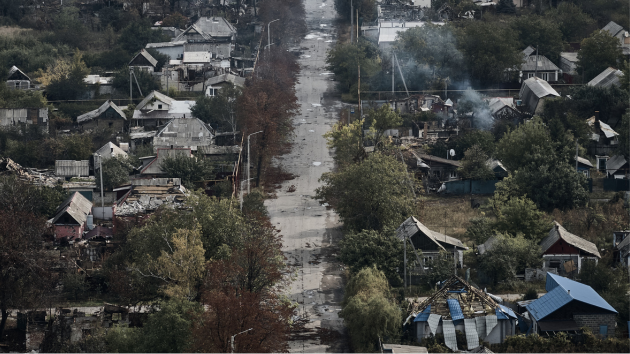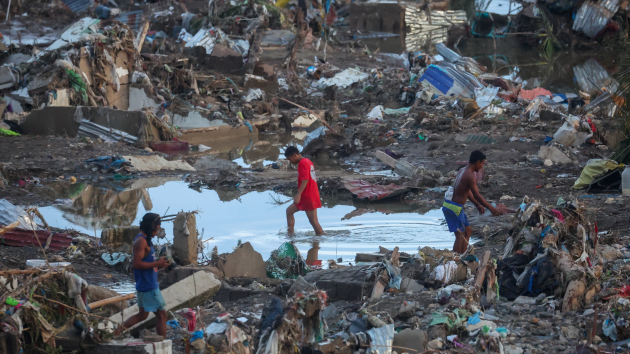What does Gaza’s future look like after a year of war?
Written by ABC Audio ALL RIGHTS RESERVED on October 7, 2024

(LONDON) — Smoke and question marks still hang over the devastated Gaza Strip a year after Hamas’ Oct. 7 attack touched off a regional firestorm.
The fighting in Gaza continues, though the epicenter of the broader conflict has now shifted north to the Israel-Lebanon border where Hezbollah is maintaining the Iran-led “Axis of Resistance” second front.
Cease-fire negotiations appear stalled. The majority of Gaza’s population remains displaced. Swaths of its homes and infrastructure are leveled. More than 46,000 are dead, according to the Hamas-run Health Ministry.
In the ruins, sporadic battles continue between the Israel Defense Forces and Hamas.
Around 100 of the 250 hostages — kidnapped during Hamas’ Oct. 7 terror attack on southern Israel, which killed around 1,200 people — remain in captivity in Gaza. Only half are thought to still be alive.
Israel launched its military response to the massacre without publicly laying out a detailed post-war vision.
Prime Minister Benjamin Netanyahu said as early as November 2023 that Israel requires “overall security responsibility” for the strip “for an indefinite period.”
That would include an expanded “security perimeter” around Gaza’s frontiers and control of the Philadelphi Corridor area along the Egypt-Gaza frontier, Netanyahu said.
Netanyahu has said his envisioned “total victory” is close. Current Israeli deployments in the strip hint at its eventual shape.
“Israel holds two narrow territorial strips — Philadelphi and Netzarim,” Michael Milshtein, a former head of Palestinian affairs for Israeli military intelligence, told ABC News.
The former is around 9 miles long and runs along the entire border with Egypt. The latter runs around 2.5 miles east to west from Israel to the Gaza coast, bisecting the strip.
“The IDF is really in these corridors and around the boundaries of Gaza,” said Orna Mizrahi, who served in the Israeli prime minister’s office as deputy national security adviser for foreign policy.
Units can launch operations deeper into Gaza from these staging points “according to the intelligence that they have,” Mizrahi said.
A year of fighting has already changed the physical and demographic map of Gaza, Milshtein said.
“Eight percent of the people who lived in Gaza before Oct. 7, they do not live in Gaza or exist in Gaza anymore,” he said, with tens of thousands having been killed or fled.
The majority of Gazans have been displaced, some repeatedly. Continued Israeli operations may force more mass movements.
Netanyahu is now considering the so-called “Generals’ Plan,” in which the IDF would evacuate all remaining civilians from the north of the strip and lay siege to the militants — and the civilians — who stay behind.
Retired Maj. Gen. Giora Eiland said the plan would turn the northern strip into “a military zone” in which “every figure is a target and, most importantly, no supplies enter this territory.”
“I’m not sure that it will really defeat Hamas,” Milshtein said of the proposal. “And of course, it won’t bring the release of the hostages.”
Israel’s ambassador to the United Nations, Danny Danon, told ABC News in September that Hamas is “almost finished.”
Hamas’ political chief Ismail Haniyeh was killed in Tehran in July. The same month, the IDF claimed to have killed infamous Hamas military leader Mohamed Deif, though the group said he survived the attempt.
Only Yahya Sinwar — Hamas’ leader in Gaza — is still thought to be alive, likely in the sprawling network of tunnels beneath the strip and possibly surrounding himself with hostages.
But Israel’s military planning does not appear to have yet given way to the political.
U.S.-sponsored efforts to build an international coalition to rebuild — and perhaps also oversee — Gaza has thus far proved fruitless.
So, too, have suggestions that the Palestinian Authority — which partially controls the West Bank in cooperation with Israel, is led by President Mahmoud Abbas and is dominated by the Fatah party — take control.
Meanwhile, far-right Israeli settler groups — among them influential members of Netanyahu’s government — are pushing to revive and expand settlements abandoned when Israel unilaterally withdrew from Gaza in 2005.
“Can you take all the tactical and military achievements, and translate them to the strategic?” Milshtein asked. “This is much more complicated.”
Also complicated is the concept of total victory over Hamas, which remains active despite reportedly massive casualties.
“They have no battalions, but that’s okay, because they rely on cells, platoons and smaller units,” Milshtein said.
“I really don’t see when or if we will see any white flag or announcement about ‘total defeat’ and ‘giving up.’ I’m not sure that it’s going to happen very soon — or at all.”
Copyright © 2024, ABC Audio. All rights reserved.





